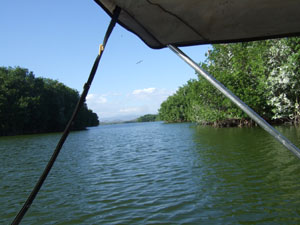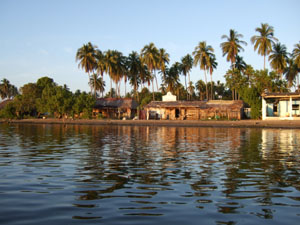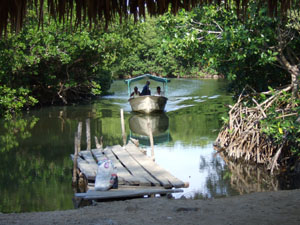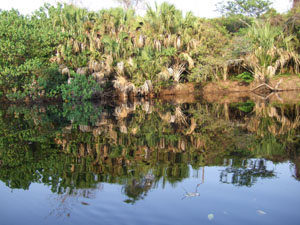LIFE AMONG
THE MANGROVES
By
Barbara Schaffer
Some of us arrive in Puerto Escondido and know we do not have to travel
any further. But travel we do, if only on short journeys up and down
the coast or into the mountains, because nothing becomes home more
than the leaving of it. My favorite escape is to Chacahua, to those
immense lagoons of still water that perfectly reflect both sky and
mangroves. As soon as I am on the launch I know I have arrived inside
a dream I had forgotten.

Mangroves are enormous trees with external vine-like roots that grow
in salt-water lagoons. Each tree is an island hosting a variety of
crustaceans, insects and birds. You can only enter a mangrove forest
by canoe as the trees are often very close to each other. The motorized
launch takes you through the open areas of the lagoon past the forests.
You don't need to be a bird watcher or an ecologist to enjoy the ornithological
and biological splendor of the lagunas of Chacahua, but it helps to
have a predisposition to abandoning oneself to great expanses of tranquil
beauty: the play of light on the water, an odd shaped cloud you might
not have noticed if you weren't on a boat, the lone man or woman fishing
from canoes (pangas or cayucos in Spanish) hidden in the mangroves
beneath branches sheltering herons and pelicans.

When, after an hour, the launch takes you to the village of Chacahua,
which is where the sea enters the lagoon, you find yourself in another
lost world. No cars, no internet, just a few hundred people who mostly
live in palapas. But there are restaurants on the beach and cabins
to stay in. My favorite is the Almendra, which is on the lagoon. It's
clean, cool and comfortable and has a spectacular view.
The inhabitants of the island are mainly of African-Mestizo and Mixteca
descent. Going along the lagoon, it's only a five-minute walk from
the beach to the village with its school and public buildings. The
houses are mainly thatched huts, often set in compounds. After the
village you can continue your walk by following the dirt road that
leads to the other end of the island.
Chacahua was Mexico's first national park and as such has been spared
development. The mangroves are protected and can only be entered by
canoe. A highlight of your visit should be a canoe trip through the
dense mangrove forests at sun set - the best time to see the birds,
and to experience the dark, labyrinth-like canals.

Although you can drive to Chacahua by taking the turn-off onto a dirt
road at San José del Progreso, the most direct route from Puerto
is through Zapotalito. The driving time from Puerto is around 90 minutes.
The turn-off is around 15 minutes from Río Grande. (You can't
miss it - there's a big sign for Chacahua and a military check point.)
You then continue down a paved road until you get to the boat landings.
There you will find launches and off-street parking.
The launches operate like taxis and can carry up to 6 people, but
they are pricey. (The rate was about $60 U.S. in January.) The most
economical way of going is by taking a bus to Río Grande and
continuing to Zapotalito by colectivo. Then you can take a short colectivo
boat ride followed by a 45-minute trip in the back of a pickup truck
over bumpy dirt roads. Not good if your back can't handle it.
Manialtepec Lagoon
Only 10 miles west of Puerto is the Laguna Manialtepec. The eco-system
is different than that of Chacahua, but it also features mangrove
forests and many different species of birds. Canadian ornithologist/naturalist
Michael Malone's Hidden Voyages Ecotours are a wonderful introduction
to the lagoon and its avian life. You can make a reservation -winter
months only - through Viajes Dimar on the Adoquin, or by calling Michael
at 954 582-2962.
Margarito, who lives in Las Negras, a village on Manialtepec, is also
a well-known guide. Although his English is limited, a trip on his
canoe through the mangroves is both a spiritual and educational experience,
as Margarito has a deep connection to the lagoon which he imparts
to his fellow voyagers. You can often find him on Zicatela or Playa
Principal looking for customers.
Ventanilla
Chacahua and Manialtepec are west of Puerto, but the mangroves continue
further down the coast. An hour east of Puerto, near Mazunte, is the
seaside village of Ventanilla, which is famous for the crocodiles
in its lagoon. The villagers maintain a very nice restaurant next
to an environmental center, where you can arrange for a canoe tour
of the lagoon. Besides being able to see crocodiles in the wild, mostly
sleeping, you can also see them and other animals in cages on an island
which is part of the tour.

If you go to Ventanilla you should also pay a visit to the Mexican
Turtle Center (Centro Mexicano de la Tortuga) in nearby Mazunte. Besides
featuring a variety of marine and land turtles at different stages
of development, there is a botanic garden, exhibitions, a restaurant
and a gift shop. It's open Wednesday through Saturday from 10-4:30,
Sunday 10-2:30.

To get to Ventanilla, take the Mazunte/Zipolite turnoff from the coastal
highway, next to a Pemex station, 35 miles east of Puerto, and then
continue straight down the paved road another five miles to the end.
There is a turnoff for Mazunte before you arrive at Ventanilla. Alternately,
you can take any bus heading to Pochutla or Huatulco, and ask to be
let off at the crucero San Antonio. From there you can take a colectivo
or taxi.
Sol de la Costa, February 2009

